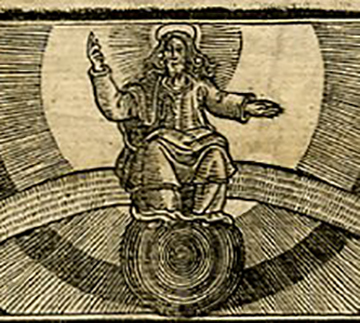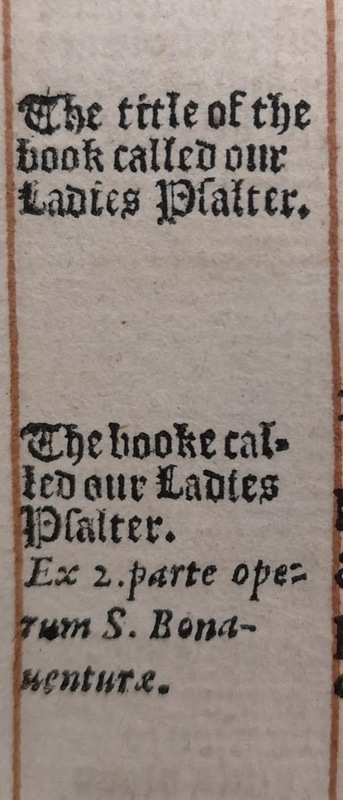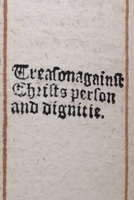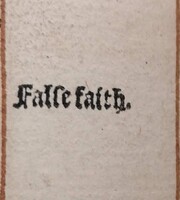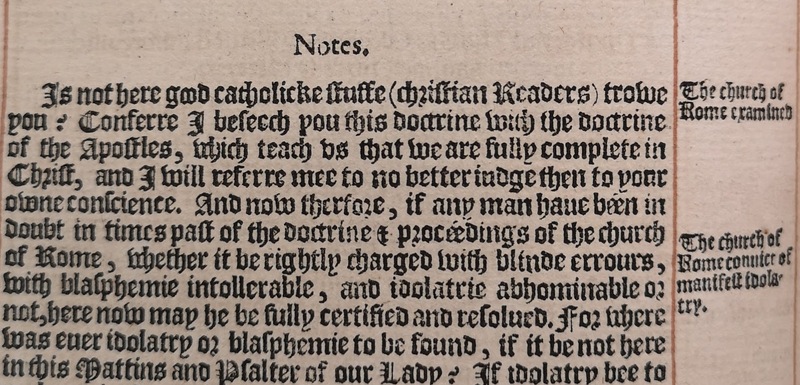The Ladies Psalter (of Popish Blasphemy)
“The booke of our Ladies Psalter full of popish blaspheamie” appears in John Foxe’s Acts and Monuments during the reign of Queen Mary, beginning on page 1452. While this Psalter does not address the queen by name, it does address women as a whole and is likely a version of Queen Mary’s psalter due to the references to Catholic faith. The opening line is greeted with a simple marginal note about the title, an innocuous beginning compared to the heated turn the marginalia takes later on. Foxe’s reaction to this psalter is highly emotional and emphatic in its declaration that it is blasphemous.
The first mention of blasphemy occurs halfway down the second column on the first page. Following a light mention of “Our Ladies beautie” Fox immediately declares the in-text plea for the mother of God (Mary) to defend us from enemies to be “Treason against Christs person and dignitie.” The next set of marginalia accuse the psalter of “Blasphemous Idolatry,” “False faith,” “Vaine trust,” “wrong innocation,” and “Manifest Idolatry.” These are common themes seen throughout the rest of the psalter, identifying each instance of perceived blasphemy and idolatry with unwavering precision.
Why This Psalter?
The question must be asked why Foxe placed such an unsavoury piece of Catholic literature within his text when so many other examples of Catholic scripture was present and available in England during Queen Mary’s reign. While there are no precise answers, speculation on the matter can and should be entertained. One possibility is the link of the psalter to Queen Mary herself. Foxe’s disdain of the queen is no secret within the pages of his text and he took any chance he had to undermine her authority and character. He may have drawn a connection between Queen Mary Tudor and the Queen Mary, mother of God, represented in the psalter and, seeing an opportunity, was able to deride Mary Tudor without taking the responsibility of insulting the currently reigning queen.
This connection between the two Marys' can be seen in this section of the psalter: “Let our enemies fall before our feete, and with thy [Mary] power dash their heads in péces” (1452). It is appropriately bloody and violent imagery that Foxe retaliates to, declaring it to be a “Derogation of the Crosse of Christ.” It could also pass, however, as a description of the actions of the “Bloody” Queen Mary who was responsible to the deaths of hundreds of Protestants.
It is logical to infer then that Foxe also held the opinion that Mary was degrading the throne of England with her Catholic presence, and that the violent actions undertaken in the Catholic God’s name were mirrored in this psalter.
Another piece of marginalia to take note of is when Foxe writes “If Mary forgive sins, then is our faith in Christ in vain,” referring to the line “My heart is inviting a new matter O[h] Ladie, oc. By thy holinesse let my sinnes be purged, by thy integritie let me obtaine incoruption” (1453). The meaning here is obvious: if Mary is allowed to absolve sins then the ultimate power and sacrifice of Jesus was in vain. This could be a reference to Mary repealing Protestant Laws and instilling Catholic charges against heretics, yet again drawing the reader’s attention to the unnaturalness and even sinful nature of Queen Mary acting as head of state.
This is further emphasized with a second piece of marginalia reacting to the line “Deliver me O[h] Lady from all evill, and from the infernall enemie, defend me” (1454), which states: “Gods office appointed to our Lady.” This follows a series of “Idolatrous innocation,” “False truth,” and “Blasphemy” marginalia placed above the statement to elicit the reader’s outrage at the action. Foxe is skillfully placing all the right words in strategic places to ensure that, by the time he reaches his main point, those reading the marginalia will be appropriately distressed.
Furthermore, by crafting the statement to say that God’s office was appointed to a women, it draws the connection to Mary taking Henry VIII’s place (disregarding the brief rule of Edward VI and Lady Jane Grey) and thus the seat as the head of the Church of England. It does not matter to Foxe that Mary rejected that seat and reinstated Catholic rule over the Protestant church, the fact remains that she ‘usurped’ the Head of the Church’s seat.
Additional examples of Foxe illustrating the connection between Queen Mary Tudor and the mother of Jesus occur in following marginalia, such as him declaring that “Mary [is] made a commander of Christ” and “Our Lady [is] made equall with God in the church of Rome.” Both statements are clear references to the actions taken by Mary Tudor and are meant to draw the ire of the reader at the audacity of both Marys’.
The language used in both pieces of marginalia is very strong. Mary is the “commander” of Christ, not just a powerful authority. She has literally usurped his position as commander of Heaven, much like Mary Tudor usurped the position of Queen from Jane Grey. Moreover, Foxe states that Mary has been made “equall” with God in the church of Rome. Not only does this display the boldness of Mary in ascending higher than her proper station, it also highlights the foolishness of the Roman Catholic Church. They have, according to Foxe, sanctioned the rise of the Lady within the Church hierarchy, placing her on an equal level with God in the eyes of the Pope. Foxe’s clever position of language within these marginalia shows the reader that they do not have to take his word only for this information, but that the Catholic church themselves have allowed this manipulation of power to occur within their own house. Foxe is likely hoping to simultaneously establish the inherently blasphemous nature of Mary (both of them) and to destabilize the authority of the Pope in the eyes of his readers, thus resulting in a ‘win’ for the Protestant faith.
A Side Note
Is not here good catholicke stuffe (Christian Readers) trowe you; Conferre I besech you this doctrine with the doctrine of the Apostles, which teach us that we are fully complete in Christ, and I will referre mee to no better judge then to you own conscience. And now therefore, if any man have been in doubt in times past of the doctrine [and] proceedings of the church of Rome, whether it be rightly charged with blinde errours, with blasphemie intolerable, and idolatrie abhominable or not, here now may he be fully certified and resolved. For where was ever idolatry or blasphemie to be found, if it be not here in this Mattins and Psalter of our Lady…The commandement sayth: Thou shalt worship the Lord thy God, and him only shalt thou serve. (1254)
It is a call to change faith and embrace salvation, to leave the Catholic trappings behind and devote yourself to God and God alone. This makes it clear that Foxe did not intend for only Protestants to read this passage. Instead, he specifically invoked the blasphemous and adulterous image of Mary as Mary to incite the anger of Protestants and Catholics alike. Foxe selected what he deemed to be an inflammatory piece of Catholic scripter to sway and convert wavering Catholics, using it to demonstrate what he deemed to be an absurdity of Catholicism.
A Reasonable Assumption
Therefore, we can successfully conclude the question to why Foxe chose such a objectionable psalter: to aid in his mission to convert Catholics, to reaffirm the Protestant faith, and to undermine the rule of Mary Tudor - all within the margins of the page, only taking his message to the main text when he felt secure that both the psalter and his marginalia had successfully rattled the faith of questioning Catholics.
Within the margins of his Acts and Monuments, John Foxe created the personas of some of the most significant women in England during the seventeenth century. He took it upon himself to instruct and show his readers how best to view Lady Jane Grey, Queen Mary I, and Queen Elizabeth I, shaping his audience to meet his standards. By reading his marginalia, we as readers can gain a deeper understanding of the text and see how he constructed female identity within his pages.
